Part 8: Electrification and the end of British Rail
Electrification, or 'electrolisation' as it was called in the dim and distant past, of main and commuter lines had been on BRs agenda for many years. The LNER had gone ahead with its Shenfield and Woodhead schemes, both 1500v DC overhead, prior to WWII but because of the war these schemes were shelved and didn't finally come into being until postwar. There were numerous third and forth rail schemes in operation from the late 19th century onwards, the first being the City & South London Railway, with all of these being relatively short distance commuter routes in and around Britains larger cities and the Southerns ultimately extensive third rail system could be included among them. Constituents of what became the Southern Railway also had some overhead electrified routes in South London and we must not forget the semi-abortive North Eastern Newport - Shildon overhead electrification which had been planned to reach southwards to York.
Third and fourth rail schemes are prone to problems with ice, leaf mulch etc. on conductor rails but modern methods are in place to deal with this fairly efficiently. Apart from that and the obvious danger to staff, who are in any case trained in safety, the conductor rail system is reliable, sturdy and is not an eyesore. Another advantage is that bridges, tunnels and other structures do not require expensive and disruptive alterations that would be necessary for overhead line equipment (OLE). One disadvantage which did not appear to be so until so-called rail privatisation, which is geared towards profits as much as anything else, came into being is the large number of electricity substations required for DC traction. At the time of writing, some operators of the former Southern Region network are making something of an issue of this while adding the dubious statement that DC is not suitable for speeds of 100mph or more. Does the former Southern network need speeds exceeding 100mph? probably not. With the exception of the Weymouth line and discounting the Channel Tunnel route, none of its routes are more than 70 - 80 miles long and stations are frequent.
The OLE system was once standardised at 1500v DC and the equipment was heavy and dependable. The alternating current (AC) OLE system at 25,000v 50Hz is now the standard and the high voltage AC system allows for fewer substations and lighter catenary equipment. The problem with OLE is that it is an eyesore and lightweight catenary is very prone to damage from storms, falling trees or even just branches and so forth. There are also problems with extreme summer heat causing overhead wires to expand and sag despite tensioning arrangements being in place. The Cambridge - King's Lynn line has proved especially prone to this.
As a momentary aside, it is strange to think the people object to things like wind turbines, new roads and so on being blots on the landscape yet seldom, if ever, object to unsightly overhead wires being erected on railways.
Readers may be surprised to learn that electrification of the railways, or a railway, to Cambridge goes back as far as 1960. A desire to electrify the East Coast Main Line had been abandoned while the West Coast scheme, initially from Euston to Birmingham, Liverpool and Manchester, went ahead and this was the reason for the introduction of the Deltics - as a stopgap pending future electrification. Or at least that was the hope; as events transpired the IC125s replaced the Deltics until the ECML was finally electrified.
The 1960 scheme embraced electrification of the King's Cross suburban route as far as Cambridge and including the Hertford loop but did not include the ECML north of Hitchin to Huntingdon or Peterborough. At that time, a few commuter trains ran as far north as Peterborough but Huntingdon was for all intents and purposes the northern limit of outer suburban services. Not much information has come to light concerning the 1960 scheme, other than rolling stock requirements which were based upon the three types seen below.
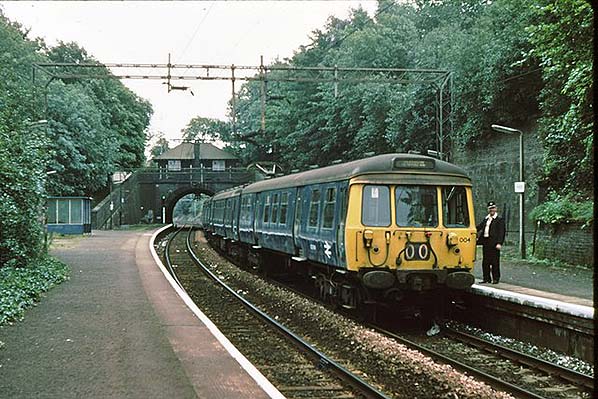
Photo by Peter Whatley reproduced from Geograph under creative commons licence
Above, at Kirkhill in 1979, is a Glasgow area EMU of the type known originally as the 'blue trains' due to their unique, at introduction, livery. The flat windscreens were a modification; originally the outer two screens wrapped around the corners. The 1960 Cambridge scheme would have required 112 three-car units based upon this design. Had the scheme come to fruition, the Glasgow-type units would have been used mainly on inner suburban services to, presumably, Welwyn Garden City and Hertford North.
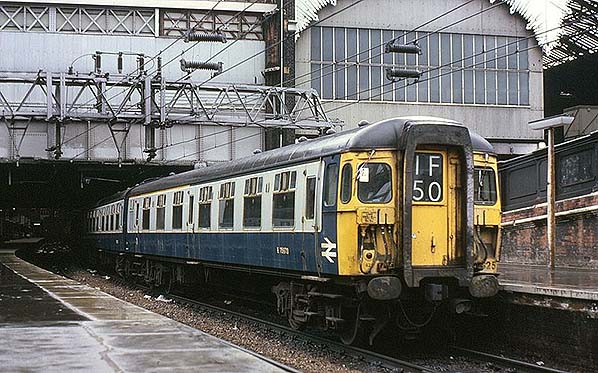
Photo by Phil Richards reproduced from Wikimedia Commons under creative commons licence
Above, in March 1981, we see a Class 309 'Clacton' unit departing Liverpool Street. These, too, originally had wrap-round windscreens. These units came in two and four-car forms and included buffet cars. The 1960 Cambridge scheme envisaged 18 'main line 4-car' sets and although specific details are not known they would almost certainly have been of this type. Presumably they would have replaced the locomotive-hauled Cambridge 'Buffet Express; and operated in an 8-car formation.
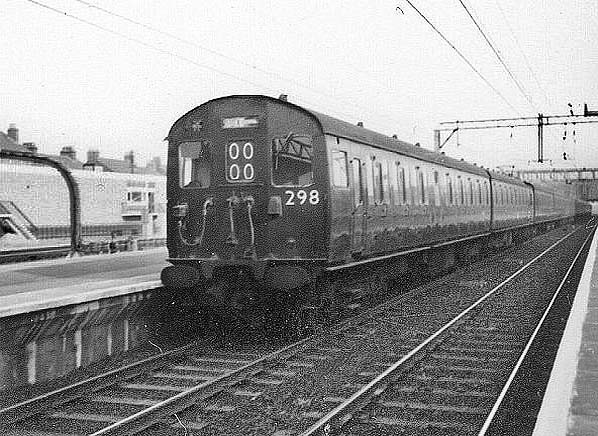
Photo by Stephen Rees reproduced from Wikimedia Commons under creative commons licence
Above, we see a Class 302, as the type was later classified at Barking c.1964,. The 1960 Cambridge scheme required 27 of these 4-car sets. The actual description stated 'Southend type sets' which could have meant Class 302 or 307 but the two types were almost identical in appearance so the above image is adequate for our purpose. These units would, had the 1960 Cambridge scheme gone ahead, have operated the outer suburban stopping services and instead of Cambridge being swamped with Cravens DMUs, the sidings and platforms would have been full of these units.
Of the three types illustrated above, Class 302 was the only one of the three which did eventually operate to Cambridge albeit, of course, from Liverpool Street rather than King's Cross.
The rolling stock requirements described above may seem excessive; a total of 157 units for a route mileage, including the Hertford loop, of around 80 miles assuming the Hertford - Stevenage section would have been reopened to regular passenger services. We should remember the rolling stock total included a maintenance float as well as adequate spare stock and stock to cover extra peak hour services or strengthening. One of the good points, and there were many, of the state-owned BR was that spare stock was almost always available and at short notice if need be and providing crews were available - which they usually were.
As far as the 1960 Cambridge scheme is concerned, so far as is known nothing much was done beyond the planning described above. At around the same time, the West Coast Main Line electrification was being extended south towards Euston while electrification from Liverpool Street to Bishops Stortford and branches had opened in 1960. Southend electrification was more or less complete so presumably funding for the King's Cross - Cambridge scheme was simply not forthcoming. The need to find work for swarms of Cravens DMUs which were otherwise redundant due to the closure of their intended M&GN haunt may also have been a factor.
On the face of it, it is perhaps surprising the Bishops Stortford - Cambridge section was not originally included in the Liverpool Street scheme, which was known at the time as the 'Chenford' electrification. This whimsical name came from Chingford, Enfield (Town), Hertford (East), Bishops Stortford. Cambridge was and still is a major junction station, all stations between Bishops Stortford and Cambridge were still open and Audley End was, then, the junction for Saffron Walden and, up to a point, Haverhill. Haverhill is a story of its own, being designated a London overspill town only to then lose its railway, in 1967, but this was the type of road-biased government skulduggery typical of the time and, it has to be said, a good proportion of the general public who saw the private car as a good excuse to stick noses in the air.
 Common sense at the time said that electrification from Bishops Stortford to Cambridge and from Audley End to Haverhill via Saffron Walden and a new chord at Bartlow (to avoid reversals; the junction at Bartlow faced Cambridge) but it was not to be. Part of the problem, or excuse, was that the Liverpool Street - Cambridge line carried longer distance trains to King's Lynn, Norwich etc. which carried most of the traffic to and from Cambridge and London. The outcome was the continuation of the not hugely frequent locomotive hauled service with Cambridge - Bishops Stortford local traffic having to put up with a DMU shuttle. Passengers wishing to travel from and to intermediate stations between Cambridge and Bishops Stortford and Bishops 'Stortford and Liverpool Street thus had to change to / from a DMU to / from a stopping EMU service. In its original form, the Bishops Stortford electric service was a humdrum half-hourly affair operating via the Southbury loop and this remained the case until the Lea Valley lines were electrified many years later. This sort of service pattern with a change to / from a DMU did absolutely nothing to encourage business at intermediate stations and the same situation existed with the later Cambridge - Royston DMU shuttle; many people - including from Cambridge - drove the short distance to Royston instead of putting up with the DMU shuttle and change of trains at Royston. Until BR realised what was happening, this gave the false impression of the Royston electrics encouraging a surge in business while the Cambridge end of the route was seeing a decrease in business.
Common sense at the time said that electrification from Bishops Stortford to Cambridge and from Audley End to Haverhill via Saffron Walden and a new chord at Bartlow (to avoid reversals; the junction at Bartlow faced Cambridge) but it was not to be. Part of the problem, or excuse, was that the Liverpool Street - Cambridge line carried longer distance trains to King's Lynn, Norwich etc. which carried most of the traffic to and from Cambridge and London. The outcome was the continuation of the not hugely frequent locomotive hauled service with Cambridge - Bishops Stortford local traffic having to put up with a DMU shuttle. Passengers wishing to travel from and to intermediate stations between Cambridge and Bishops Stortford and Bishops 'Stortford and Liverpool Street thus had to change to / from a DMU to / from a stopping EMU service. In its original form, the Bishops Stortford electric service was a humdrum half-hourly affair operating via the Southbury loop and this remained the case until the Lea Valley lines were electrified many years later. This sort of service pattern with a change to / from a DMU did absolutely nothing to encourage business at intermediate stations and the same situation existed with the later Cambridge - Royston DMU shuttle; many people - including from Cambridge - drove the short distance to Royston instead of putting up with the DMU shuttle and change of trains at Royston. Until BR realised what was happening, this gave the false impression of the Royston electrics encouraging a surge in business while the Cambridge end of the route was seeing a decrease in business.
With regard to the Stortford, as the town is commonly called, to Cambridge line, it was commonly believed during the 1960s and 1970s that electrification was intended to reach Cambridge and that some work had been done between Stortford and a point near Audley End viaduct (a little known structure, outside of railway circles, near Newport). However, there is absolutely no evidence of this either on the ground or on paper. Some bridges were rebuilt around that time, including Hills Road bridge and another just south of Shelford, but probably not in connection with electrification. In any event, bridge rebuilding for whatever reason was by then undertaken as standard practice to allow for any future electrification irrespective of whether any such schemes were pending. A good and well-known example of this practice was the bridge carrying the Histon bypass over the Cambridge - St Ives line; many local people assumed this was done because the St Ives line was to be electrified but, of course, this was not the case. Today this same bridge carries traffic over the guided busway.
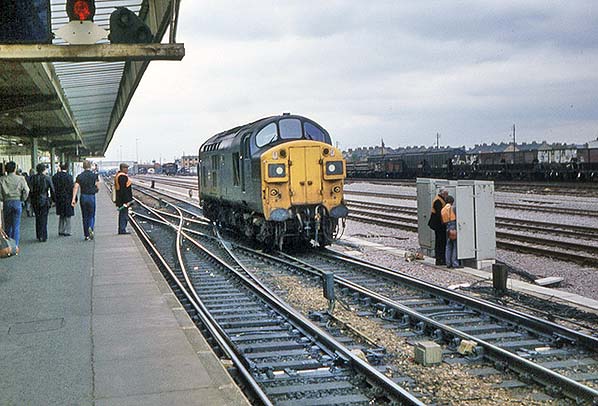
Photo
by Pat Newson from Cambridge area 1980s Flickr photostream
The above image, taken some time in 1982, may look irrelevant but is actually quite interesting. As a prelude to electrification, albeit still unauthorised at the time, there was alterations to the carriage sidings and the resignalling scheme was well underway. Evidence of both can be seen above. The siding alterations are indicated by the clean ballast and it was this work which uncovered the subway to, and foundations of, the second 19th century island platform as described in Part 1. The subway passes beneath the track approximately where the nearest end of the Class 37 is positioned. Given that the reballasted track nearest to the camera marks the site of the 19th century second island platform and that the platform on the left was originally the site of the track through the colonnade, it is reasonable to assume there were two tracks between the colonnade and island platform.
As mentioned, it is today absurd to think that an important city and railway junction like Cambridge had, for nine years, to put up with a basically two-hourly through service to London, peak times excepted, on - and only on - the Liverpool Street line and otherwise having to make do with DMU shuttles and changes of trains. But the politics of investment in the railways were complex (although not as complex as today, ironically) or, perhaps, deliberately made complex. Also, when examining the history of electrification, or lack of it, to Cambridge it is difficult to ignore the suspicion that BR's then divisional boundaries were used as a political football until things began to change under Network SouthEast auspices which embraced the entire London and South East area. Neither of the electrification schemes to Cambridge were large projects but merely extensions of existing schemes and schemes which did not even require any additional rolling stock excepting a few Class 86 locomotives for the Liverpool Street - Cambridge leg of the rather dire King's Lynn service which remained for a time. One cannot therefore help wondering if a certain organisation, for centuries known for opposing progress in Cambridge, was in any way behind the stalled electrification schemes which, remember, go back as far as 1960.
The Liverpool Street Line
Mrs Thatcher's government finally approved electrification between Bishops Stortford and Cambridge in January 1984 but this did not include the short gap between Shepreth Branch Junction and Royston, supposedly because "it would increase costs" which is a glaringly obvious and thus rather pointless statement. The wires at Royston actually extended towards Meldreth as an over-run so technically the gap was even shorter and the same applied at Bishops Stortford where the wires, installed in 1960, extended part way to Stansted. With Cambridge PSB and the area resignalling in operation, electrification of the 25 or so miles from Bishops Stortford was straightforward. The wires reached Cambridge during late 1986 and were energised in early December of that year. The first electric train to depart from Cambridge did so on 19 January 1987, formed of EMUs 305507/18 and full electric services to Liverpool Street commenced on 8 May 1987. During the initial period, the local electric service south of Cambridge simply replaced the former DMU shuttle to Bishops Stortford and ran to its times. The journey was thus rather leisurely but at least it was free of the rasps and rattles of Cravens, that one-time local speciality. On 3 May 1987 a special unlimited 'runabout' ticket was issued, valid on the Bishops Stortford - Cambridge section, for a very reasonable £1.
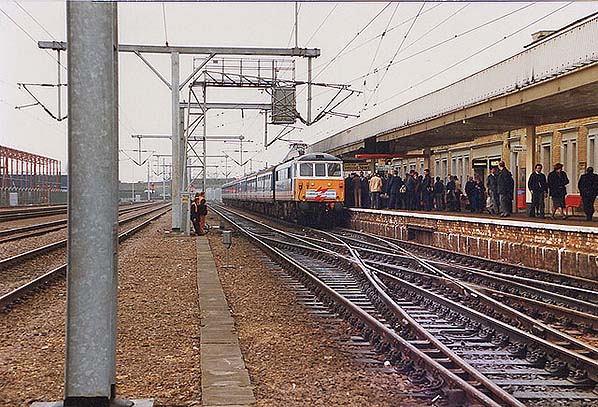
Photo
by Pat Newson from Cambridge area 1980s Flickr photostream
Above we see Class 86 electric locomotive 86401 at Cambridge on 23 March 1987. The locomotive had been repainted in NSE livery specially for the occasion, which should have taken place on 19 January but had been postponed due to severe weather conditions. The train was a special working for publicity purposes and had covered the run from Liverpool Street in 48mins. This was good going as the Liverpool Street line is not an easy one and is plagued by speed restrictions due to congestion at the London end. For a few years the wires ended at Cambridge and a handful of Class 86 locomotives, five it is thought, were drafted in to operate King's Lynn services which, as mentioned, were dire following electrification to Cambridge. There was just three or four per day with the electric locomotives being replaced by Class 47 diesels for the section north of Cambridge. At other times of the day, King's Lynn had to make do with a DMU shuttle between there and Cambridge. Usually, 3-car Metro-Cammell units were in charge.
Local services between Cambridge and Liverpool Street used number of existing slam-door EMU types. Classes 305 and 308 were common and the flat-ended Class 302 could also turn up from time to time. Inner suburban Class 315 units could also appear and continued to do so until the much later Class 379 appeared which meant a number of Class 317 units were spare. The latter, together with other sliding-door types, had eventually taken over with the dispersal or withdrawal of the older slam door types, some of which became parcels units while others went to the North West, West Yorkshire and Scotland for spells of further service.
On the left of the above image can be seen the framework of a new Royal Mail depot partly on the site of the former GER goods shed.
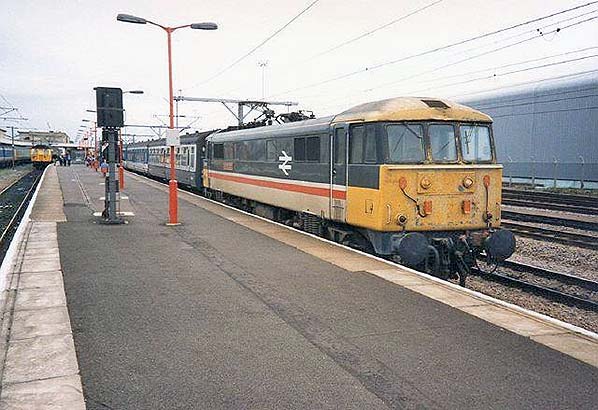
Photo
by Pat Newson from Cambridge area 1980s Flickr photostream
Above, later in 1987, we see 86221 waiting to depart Cambridge with a Liverpool Street service. It is not clear if this is one of the trains to have come from King's Lynn behind a Class 47 diesel or if it is starting from Cambridge. The lack of activity, without even a driver in sight, suggests the latter. The Class 86 was named 'Vesta' and then renamed 'BBC Look East' with the renaming taking place on 10/11 May 1987 but the photograph is not clear enough to confirm which name is carried. Later receiving Anglia Railways livery, 86221 moved to Norwich services and was withdrawn in 2003. There is an untidy mix of liveries typical of the time; 86221 is still in unbranded Inter-City livery while coaches in both Blue/Grey and Network SouthEast liveries can be seen. In platform 2 a Class 305 or 308 EMU stands while in platform 3 lurks what appears to be a DMU and another EMU. The platform at this end of the station had recently been extended, hence the very obvious change in platform surface and edging. On the right, the Royal Mail building now has cladding but it was not rail served. At this time, Royal Mail was unhappy with BR's handling of their traffic and in response BR converted a number of otherwise redundant DMUs and EMUs for parcels use. These were frequently seen skulking around platform 3 and the loading dock behind it., together with one or two of the purpose-built motor parcels vans of Class 128. Royal Mail were to later abandon the railways altogether, claiming road transport was quicker and cheaper. Perhaps needless to say, Royal Mail soon returned, quietly, to the railways but the days of little red vans and mailbags waiting at railway stations are long gone.
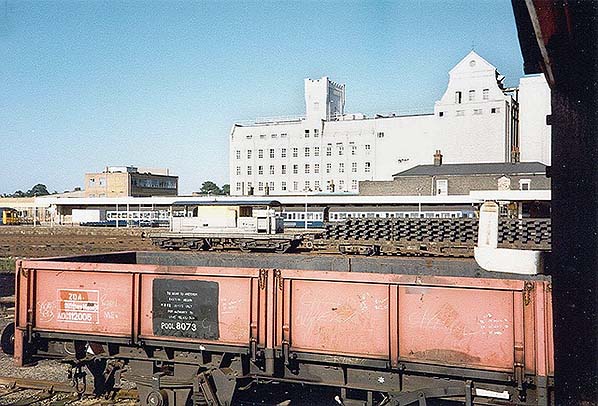
Photo
by Pat Newson from Cambridge area 1980s Flickr photostream
Above is an unusual view of the south end of Cambridge station across the goods yard. In the background the former GNR station building can be seen on the right, a nice and clean Spillers Mill, centre, and the Spillers research building, left. In the bay waits a Class 305 EMU in blue / grey livery while on the extreme left is a Swindon Class 120 DMU. The DMU is probably one of those converted for parcels use; the type, in passenger form, was once common at Cambridge but on services from the north and they were rare at the south end of the station.
Another type of electric traction or, rather, former electric traction, is also visible above. Astute readers will spot it immediately; the Southern Queen Mary brake van beyond the ZDA wagon. The London, Brighton & South Coast Railway had some south London lines electrified on the 6.6kV AC overhead system and among the various types of stock was the 'CW' units. These operated to Coulsdon and Wallington, hence the class letters. The CW stock was an oddity in that it consisted of driving trailers, non driving trailers and driving motor luggage vans. The driving motor luggage vans were essentially Bo-Bo electric locomotives with a cab at each end plus a guards and luggage compartment. Trains could be formed in a number of combinations to suit requirements providing the non driving trailer was not at either end. The driving motor luggage vans could be marshalled anywhere in the trains but they appear to have generally been sandwiched between coaches. The Southern Railway, formed at the 1923 Grouping, decided to standardise on the third rail system still in use today and the former LB&SCR overhead stock was converted to third rail DC form. That is, except the driving motor luggage vans of which a total of 21 existed. These were dismantled and any reusable parts salvaged but their underframes and demotored bogies were used as the basis for the Queen Mary brake vans. The fleet was enlarged and later examples had purpose-built underframes. It is not known which type the brake van seen above was but nevertheless the story is an interesting one worthy of a mention.
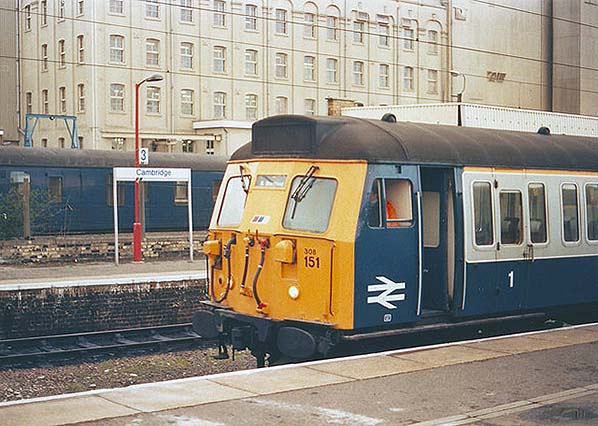
Photo by A.J.Crowther from his Flickr photostream
Above, on 9 April 1988 a clean and tidy 308151 awaits departure from platform 2. Despite the destination blind, the train is recorded as being a Stratford service and this will be correct for the date. The station has Network SouthEast trimmings but the EMU retains BR blue / grey livery which suited these units rather better than the green or solid blue of earlier times. A NSE sticker has been applied to the cab front. The Stratford service runs, at the time of writing, on Sundays only apart from one or two weekday peak workings. Following the introduction of a new timetable in May 2015 the service now runs to Liverpool Street via Hackney Downs. The weekday service had been cut back to Bishops Stortford, leaving an uneven off-peak service interval from Cambridge with two trains departing within 17 minutes of each other and then nothing for 43 minutes apart from Stansted Airport services.
The Network SouthEast station nameboards were a neat and sensible design, unlike today with countless variations across the system which change according to whoever is running a franchise in any given week.
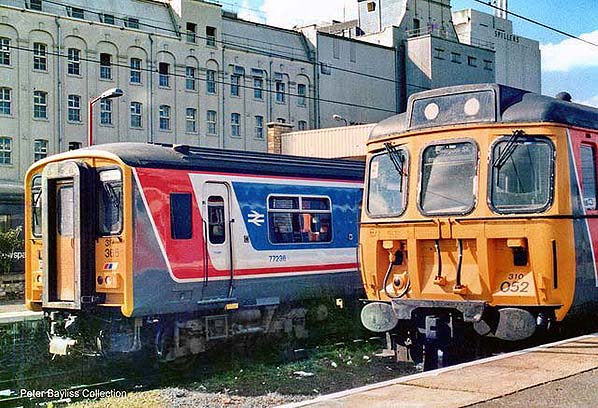
Photo from Peter Bayliss Flickr photostream
Above, in all their Network SouthEast glory we see 317365 on a King's Cross service and 310052 on a Liverpool Street service in June 1988. Class 317 had begun life on the St Pancras - Bedford Bedpan line before being replaced by Class 319. The Bedpan 317s then spent a short time on suburban services out of Euston before being moved to Cambridge services. Later batches were built especially for Cambridge services and worked to both Liverpool Street and King's Cross. They were the first EMUs to work north to King's Lynn; they were quite noisy units to travel in and although fine for London - Cambridge they were not entirely suited to the relatively lengthy King's Cross - King's Lynn services. Class 365 replaced them on services north of Cambridge but they remained prolific at Cambridge and at the time of writing still are. The majority of King's Lynn - London trains had, of course, been switched to King's Cross with electrification north of Cambridge.
Class 310 was an older slam-door type dating from 1963. They began life on services out of Euston and although essentially an outer-suburban design they worked as far as Birmingham New Street if not, on occasion, beyond. They later moved to the London, Tilbury & Southend before finding their way onto the Great Eastern section, or West Anglia as the Cambridge lines came to be known. They were similar to Class 312 which, of course, also appeared at Cambridge from King's Cross. The Classes harked back somewhat to first generation DMUs in that passengers sitting behind the driving cabs had a view of the track ahead, or behind depending upon the direction of travel.
The Network SouthEast livery was a refreshing change from blue/grey but whether or not it entirely suited certain types of rolling stock is a matter of opinion.
Differences between Class 310/2 and 317 obvious but a major difference perhaps not so obvious was that Class 317 was based upon the BR MkIII bodyshell while Classes 310 and 312 were based upon the MkII bodyshell, with Class 312 being the final type to do so.
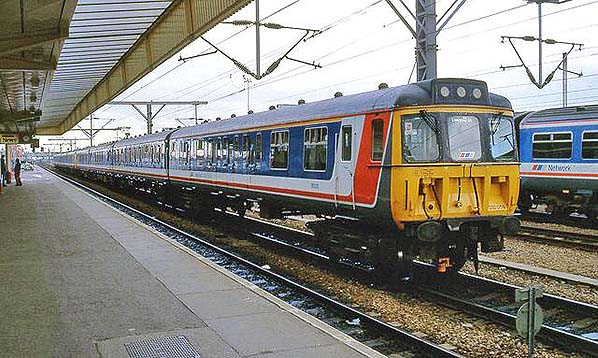
Photo by John Law from his Flickr photostream
Above, on an unknown date in 1989 an NSE liveried 8-car EMU headed by 310059 is seen at Cambridge. Presumably it will use the scissors crossing to access platform 1 and take up a service to Liverpool Street.. On the right is either a Class 317 or 321 EMU.
The King's Cross Line
Following the 1960 non-starter described earlier, government finally gave approval for electrification of King's Cross suburban services in August 1971. The first stage was Welwyn Garden City and Hertford North to Moorgate, taking over London Transport's Northern City Line which, although a tube line, had been built to accommodate stock of main line dimensions. The Great Northern & City, to give its original title, ran in tunnel from Finsbury Park where its station was underground. Construction of the Victoria Line used part of the tunnels so the Northern City had to be cut back to Drayton Park. The disused tunnels north from the latter remain to this day, still with some track in situ. Meanwhile, back in the 1930s, London Transport had planned to incorporate the Northern City in its Northern Heights scheme and to this end a connection was built from Drayton Park to Finsbury Park surface station. From here, tube trains were to have run to Highgate High Level then to Alexandra Palace, High Barnet and Bushey Heath via Mill Hill East and Edgware. In the event, due to WWII and postwar 'Green Belt' plans, only Mill Hill East and High Barnet were to see tube trains but via Highgate Low Level (the present Highgate Northern Line station). The connection between Drayton Park and Finsbury Park surface station was therefore never used for its intended purpose and lay forgotten for some forty years. It was this connection, albeit with alterations, which allowed Stage 1 of the Great Northern Electrics, as the scheme was billed, to reach Moorgate.
For Stage 1 a fleet of 64 Class 313 units was built, these being equipped to operate from OLE or third rail - the latter being needed for the former Northern City line with changeover accomplished at Drayton Park. The Northern City, incidentally, was the scene of the 1975 tube disaster when a train comprising 1938 tube stock units 175 and 115 ran at speed into the dead-end tunnel of Moorgates platform 9.
Stage 2 covered King's Cross - Royston for which 26 Class 312 units were built. British Rail's original plan had been to electrify to Cambridge and apparently the order for 26 Class 312 units provided for this. However, at some point electrification of the Royston - Cambridge section was dropped. A British Rail document from 1973 mentions the wires extending only to Royston and with a DMU shuttle between there and Cambridge and this was indeed what happened. Electric trains commenced serving Royston in May 1978, over one year late (April 1977 had been the original intention).
As an interesting aside, Stage 2, the outer suburban electrification, had provided for the freeing-up of one bore of Copenhagen Tunnel (King's Cross) to allow the building of a rail link to Maplin Airport. Nothing to do with a certain TV comedy set in a holiday camp, the proposed Maplin Airport was better known as Foulness; a highly controversial scheme for a third airport for London. In the end the already existing Stansted Airport became the location.
 Quite why electrification of the Royston - Cambridge section was dropped is not entirely clear to this day. Reasons given varied; insufficient traffic from Meldreth, Shepreth and Foxton; Cambridge had Liverpool Street as its main London terminus; upgrade work too expensive. All of those reasons were, well, not exactly fabrications but no account appears to have been taken of the extra business regular interval electric services attract and this benefit had been well known for many years. Meldreth, Shepreth and Foxton had, in pre-electrification days, a somewhat sparse service outside of weekday peak times but business has increased significantly since electrification and this rather proves the point. The real reason the wires stopped at Royston was probably the already mentioned matter of the politics of the then BR divisional boundaries and perhaps this is borne out by the speed at which things changed after the formation of Network SouthEast, or London & South Eastern as the sector was named between 1982 - 1986.
Quite why electrification of the Royston - Cambridge section was dropped is not entirely clear to this day. Reasons given varied; insufficient traffic from Meldreth, Shepreth and Foxton; Cambridge had Liverpool Street as its main London terminus; upgrade work too expensive. All of those reasons were, well, not exactly fabrications but no account appears to have been taken of the extra business regular interval electric services attract and this benefit had been well known for many years. Meldreth, Shepreth and Foxton had, in pre-electrification days, a somewhat sparse service outside of weekday peak times but business has increased significantly since electrification and this rather proves the point. The real reason the wires stopped at Royston was probably the already mentioned matter of the politics of the then BR divisional boundaries and perhaps this is borne out by the speed at which things changed after the formation of Network SouthEast, or London & South Eastern as the sector was named between 1982 - 1986.
The Cambridge area resignalling of the 1980s often mentioned within this feature had been given the go ahead in May 1978. This included the Cambridge - Royston section, the latter had become the limit of King's Cross control under that areas resignalling. This work done, approval for wiring the gap between Royston and Shepreth Branch Junction was given on 4 March 1987. Shepreth Branch Junction to Cambridge was already electrified, of course. The gap in electrification beyond Royston is often quoted as 13 miles (to Cambridge) or 12 miles (to Shepreth Branch Junction). If the over-run in the OLE at Royston is taken into account, the actual gap requiring wiring was in fact a mere ten miles. The cost of this work, referred to as "infill electrification" was a trifling £2.5m. The reason given, in view of excuses previously given for ending the wires at Royston, was the cost of maintaining the by-then-elderly DMUs operating the shuttle. Given that enough Class 312 units had been built to cater for electrification to Cambridge, the problems of continued operation of DMUs which were already over 20 years old in 1978 really ought to have been foreseen. Furthermore, additional money had been spent at Royston to allow DMUs and EMUs to use the same platform simultaneously in order to make life easier for passengers changing trains.
Apart from the problem of ageing DMUs, a further justification for electrifying the gap was that power could be taken from the substation for the then-yet-to-be-built Stansted Airport rail link some sixteen miles away as the proverbial crow flies. Whether this is what in fact happened is not known.
Approval given, little time was wasted. Just nineteen days later on 23 March 1987 the first works train left Cambridge behind Class 47 47576 wearing appropriate NSE livery. The departure was witnessed by David Mitchell, the then Minister of State for Transport. The overhead catenary was energised on 4 April and the first electric trains ran on 2 May 1988. This was a Bank Holiday Monday and the trains were special Cambridge - Royston shuttles. The full electric service commenced on 16 May meaning, of course, passengers could travel through to King's Cross for the first time in ten years without having to change.
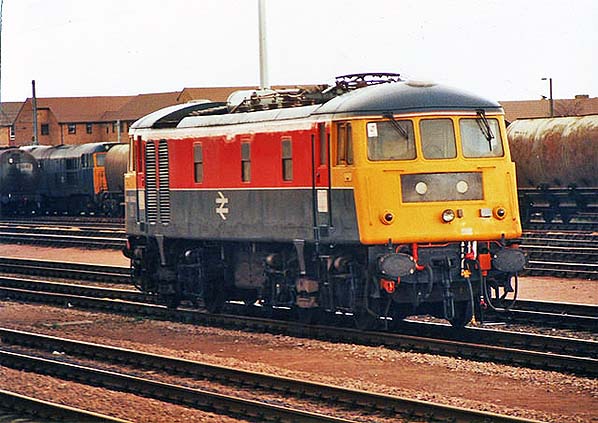
Photo by A.J.Crowther from his Flickr photostream
Above is ADB968021 at Cambridge on 9 April 1988. This departmental former electric locomotive was used for load bank testing of electrified lines. Using its own onboard equipment to simulate load and with pantograph raised, it was towed by a diesel locomotive to test the correct operation of circuit breakers and other devices. ADB968021 was used thus for testing the Shepreth Branch Junction - Royston section and may also have been used between Cambridge and Bishops Stortford. It was a common sight across the country wherever such testing was required.
ADB968021 began life as a member of Class AL4 (AC locomotive type 4) in 1960. There were ten examples, originally numbered E3036 to E3045 and built by the North British Locomotive Co. to a GEC design. The class was troublesome and underwent at least two rebuilds but was never successful. The type 4 of AL4, incidentally, had no connection with the type 4 power classification of diesel locomotives. The AC electric locomotives were given an AL number according to their manufacturers as follows; AL1 AEI / BRCW; AL2 Beyer Peacock / Metro-Vick; AL3 English Electric; AL4 North British GEC; AL5 BR Doncaster; AL6 split between BR Doncaster and English Electric. These became Classes 81 - 86 respectively. The later Class 87 was built at Crewe and carried TOPS numbers from the outset although the first 34 had been allocated the never-carried numbers E3201 - 34.
Built for the West Coast Main Line electrification which at the time was confined to the initial Crewe / Liverpool / Manchester scheme, the AL4s eventually became Class 84 and renumbered under TOPS as 84001 - 10. Withdrawals began as early as 1977 and the entire class had gone by 1980. Three initially evaded the scrapman; 84003 and 84009 entered departmental service as ADB968022 and ADB968021 respectively but the former was later scrapped without being renumbered. ADB968021 itself was scrapped in 1995 when its load bank duties were concluded.
Of the three to initially evade the scrapman, the survivor is 84001, originally E3036, now the property of the National Railway Museum and resident at Barrow Hill at the time of writing.
Initially Class 312 operated services to Cambridge but these were soon sent elsewhere and replaced by further builds of Class 317. Class 321 was and still is at the time of writing common at Cambridge as is the Networker Class 365. The latter can only be found on King's Cross outer suburban services but it is understood that some, at least, will move to what was BR Western Region and replaced on Cambridge services by new Thameslink stock.
Class 313 could also be seen at Cambridge on rare occasions. Despite being limited to 75mph their better acceleration and braking meant they were well capable of keeping to time. Class 313 was eventually prohibited from working beyond Foxton due, apparently, to problems with tripcocks (needed for the Drayton Park - Moorgate section) and third rail shoegear being damaged by high ballast shoulders between Shepreth Branch Junction and Cambridge. They are similarly prohibited from working north of St Neots. When new, Class 313 had a rather odd passenger door system; handles were provided on the (sliding) doors and passengers needed to give the handles a little tug to activate the door opening mechanism. This system was not a success and was soon replaced by more conventional arrangements.
It is often said that electrication schemes such as Royston - Shepreth Branch Junction and Cambridge - King's Lynn (which commenced operation in 1992) were done 'on the cheap'. How true this is depends upon ones perspective. The actual, even semi official, answer is that such routes were electrified to suit the level of service in place at the time. Whilst this approach did not take into account future traffic increases, it did keep cost estimates down and thereby increased the chances of funding being forthcoming. In that respect, British Rail could be said to have taken the correct approach. It has, however, caused problems for the King's Lynn line as we will see in the Thameslink section.
The Stansted Airport Rail Link
With Stansted, originally a wartime aerodrome, designated as one of Londons main airports, a rail link was opened in 1991. It branches off the Liverpool Street - Cambridge line between Stansted Mountfitchet and Elsenham. There is a triangular junction comprising Stansted South, North and East Junctions; the south chord is double track and the north chord single track - the latter carrying trains to / from Cambridge. Rolling stock of various classes has been used over the years; this has ostensibly been dedicated stock branded Stansted Express but in practice has been used turn and turn about with Cambridge stock. It is therefore nothing unusual to see Stansted Express branded stock at Cambridge.
For many years the service pattern was every 15mins Liverpool Street - Stansted Airport with intermediate stops varying, with Cambridge served only by the hourly diesel service from, currently, Birmingham New Street. More recently, a Cambridge - Stansted Airport off-peak shuttle has been introduced using Class 317 EMUs. Under normal circumstances this is the only electric service south from Cambridge not to penetrate London. At the time of writing Class 379 operates Liverpool Street - Stansted Airport services as well as some of the Liverpool Street - Cambridge services.
Thameslink 2000
Thameslink began life as a British Rail project, hence it is covered here in Part 8.
 Thameslink 2000, as it was once billed, is the second stage of the Thameslink programme, the first being the Bedford - Brighton scheme which commenced operations in 1988. This had proved hugely successful and was in a sense a revival of cross-London trains which ran via Snow Hill Tunnel and Holborn Viaduct Low Level but ceased during WWI. The second stage was Cambridge and Peterborough to destinations south of London but before this could happen a number of issues concerning capacity, mainly within central London, had to be addressed. Plans for this were drawn-up and with legalities and funding settled by 2007, work began in October of that year. The work involves a major rebuilding of London Bridge station, extra new underground platforms at St Pancras and a number of other projects including a new tunnel to link the Great Northern line with the St Pancras line. This is Canal Tunnel, just north of King's Cross, which was built at the same time as the HS1 link to St Pancras International. The entire project is due for completion by, or during, 2018.
Thameslink 2000, as it was once billed, is the second stage of the Thameslink programme, the first being the Bedford - Brighton scheme which commenced operations in 1988. This had proved hugely successful and was in a sense a revival of cross-London trains which ran via Snow Hill Tunnel and Holborn Viaduct Low Level but ceased during WWI. The second stage was Cambridge and Peterborough to destinations south of London but before this could happen a number of issues concerning capacity, mainly within central London, had to be addressed. Plans for this were drawn-up and with legalities and funding settled by 2007, work began in October of that year. The work involves a major rebuilding of London Bridge station, extra new underground platforms at St Pancras and a number of other projects including a new tunnel to link the Great Northern line with the St Pancras line. This is Canal Tunnel, just north of King's Cross, which was built at the same time as the HS1 link to St Pancras International. The entire project is due for completion by, or during, 2018.
Rolling stock will be the Siemens Class 700 of which 60 will be 8-car and 55 12-car. New depots will be built at Hornsey and Three Bridges; consideration had been given to a new depot at Cambridge (and other locations) but the idea was later dropped. Instead Cambridge will have just stabling facilities for the new trains.
King's Lynn had been intended as the northern terminus of Cambridge line Thameslink services but this has now been cut back to Cambridge. Mention was made earlier of electrification projects designed for the level of service in place at the time. Parts of the Ely - King's Lynn line are now single track and the power supply limits the number of electric trains which can occupy the route at any given time. Whilst this is adequate for the present level of service, major upgrades would be required for Thameslink Class 700 trains and it appears the cost of this cannot be justified. It therefore looks likely King's Lynn will retain a service similar to the present after Thameslink arrives at Cambridge although, of course, this could change at some point in the future.
The end of British Rail
The British Coal and British Rail (Transfer Proposals) Act 1993 saw the end of British Rail on 19 January 1993 under the Conservative government of John Major. Privatisation, not just of the railways, had very much been an aim of the previous government under Margaret Thatcher but even Mrs Thatcher herself said privatisation of the railways was "A Privatisation Too Far" but she was outvoted on the issue and thus forced to concede. Following defeat of the Conservatives and election of a Labour government in 1997, the new Prime Minister, Tony Blair was questioned in the House of Commons about reversing rail privatisation but his response was that so much money would be involved that it would be better to leave things as they are and see how it goes. At the time, Tony Blairs response was probably a sensible one but the issue of renationalisation of the railways is one that will not go away.
Time has shown that 'private' is something of a joke. First, the somewhat disastrous Railtrack went back into state hands as Network Rail, then there was the East Coast fiasco and now many Train Operating Companies (TOCs) are owned, or part owned, by the state owned railways of foreign countries via subsiduary organisations set up for the purpose. Furthermore, there is now more government interference than there ever was with British Rail. Put very simply, British Rail were allocated their budget each year and more or less left to get on with it. Whilst British Rail was for almost its entire existence the butt of jokes, it has to be said that it did an excellent job under difficult circumstances.
Todays 'privatised' railway has seen newer trains, increased frequencies and, in many cases, better services all round but this probably would have happened anyway had British Rail received adequate funding. BR in the run-up to 'privatisation' had worked well as a result of sectorising; Inter City, Regional Railways, Network SouthEast and the freight sectors. Had this template been built upon we may today have a rail network far less complex and fragmented than it currently is and with some sort of corporate image and easy to understand ticketing system. Worse is the fact that 'privatisation' was pushed through on the pretext of providing more investment without burdening the taxpayer and the fare-paying passenger. It has failed in respect of the taxpayer and while fares are perhaps not generally as horrendous as the media loves to make out, some really are quite absurd but much depends upon area and TOC concerned. In trying to take an 'on the fence' approach, local train fares cannot be said to be unreasonable while the London Travelcard, available from Cambridge, is excellent value.
Beyond the above comments, it is outside the remit of this feature to discuss in depth the rights and wrongs and the politics of rail 'privatisation'.
The BR double arrow logo survives, just, as a national railway symbol but the otherwise total lack of any national identity does little to inspire confidence. There was something reassuring about British Rail in that whether one was in Truro or Thurso, Beccles or Barrow, Acton or Aberystwyth, Cambridge or Carlisle one always felt in the same dependable hands. Some parts of British Rail had become very rundown; for example, many unstaffed stations had reached a despicable state of dereliction and depressiveness but the blame for that lay with funding, or lack of, and the constant pressure this placed BR under. On the other hand, there was also much modernisation; electrification, the highly successful HST fleet, the Sprinter DMU fleet and so on. As said, British Rail did a very good job under difficult circumstances and in truth were really not as bad as is made out.
British Rail finally bowed out in September 2013 with the abolition of British Railways Board (Residuary) Ltd., a body which existed to manage British Rail's liabilities such as bridges, tunnels and other structures on abandoned railways, legal matters and so on. Responsibilities, as of May 2015, now lie with a number of other organisations; Highways Agency Historical Railways Estate; London & Continental Railways Ltd; Network Rail; Rail Safety and Standards Board; Department for Transport. The latter two deal only with paperwork issues and legal matters relating to the former British Rail.
Click here for Part 9: The railway at Cambridge post British Rail or return to Cambridge home page




 Common sense at the time said that electrification from Bishops Stortford to Cambridge and from Audley End to Haverhill via Saffron Walden and a new chord at Bartlow (to avoid reversals; the junction at Bartlow faced Cambridge) but it was not to be. Part of the problem, or excuse, was that the Liverpool Street - Cambridge line carried longer distance trains to King's Lynn, Norwich etc. which carried most of the traffic to and from Cambridge and London. The outcome was the continuation of the not hugely frequent locomotive hauled service with Cambridge - Bishops Stortford local traffic having to put up with a DMU shuttle. Passengers wishing to travel from and to intermediate stations between Cambridge and Bishops Stortford and Bishops 'Stortford and Liverpool Street thus had to change to / from a DMU to / from a stopping EMU service. In its original form, the Bishops Stortford electric service was a humdrum half-hourly affair operating via the Southbury loop and this remained the case until the Lea Valley lines were electrified many years later. This sort of service pattern with a change to / from a DMU did absolutely nothing to encourage business at intermediate stations and the same situation existed with the later Cambridge - Royston DMU shuttle; many people - including from Cambridge - drove the short distance to Royston instead of putting up with the DMU shuttle and change of trains at Royston. Until BR realised what was happening, this gave the false impression of the Royston electrics encouraging a surge in business while the Cambridge end of the route was seeing a decrease in business.
Common sense at the time said that electrification from Bishops Stortford to Cambridge and from Audley End to Haverhill via Saffron Walden and a new chord at Bartlow (to avoid reversals; the junction at Bartlow faced Cambridge) but it was not to be. Part of the problem, or excuse, was that the Liverpool Street - Cambridge line carried longer distance trains to King's Lynn, Norwich etc. which carried most of the traffic to and from Cambridge and London. The outcome was the continuation of the not hugely frequent locomotive hauled service with Cambridge - Bishops Stortford local traffic having to put up with a DMU shuttle. Passengers wishing to travel from and to intermediate stations between Cambridge and Bishops Stortford and Bishops 'Stortford and Liverpool Street thus had to change to / from a DMU to / from a stopping EMU service. In its original form, the Bishops Stortford electric service was a humdrum half-hourly affair operating via the Southbury loop and this remained the case until the Lea Valley lines were electrified many years later. This sort of service pattern with a change to / from a DMU did absolutely nothing to encourage business at intermediate stations and the same situation existed with the later Cambridge - Royston DMU shuttle; many people - including from Cambridge - drove the short distance to Royston instead of putting up with the DMU shuttle and change of trains at Royston. Until BR realised what was happening, this gave the false impression of the Royston electrics encouraging a surge in business while the Cambridge end of the route was seeing a decrease in business.






 Quite why electrification of the Royston - Cambridge section was dropped is not entirely clear to this day. Reasons given varied; insufficient traffic from Meldreth, Shepreth and Foxton; Cambridge had Liverpool Street as its main London terminus; upgrade work too expensive. All of those reasons were, well, not exactly fabrications but no account appears to have been taken of the extra business regular interval electric services attract and this benefit had been well known for many years. Meldreth, Shepreth and Foxton had, in pre-electrification days, a somewhat sparse service outside of weekday peak times but business has increased significantly since electrification and this rather proves the point. The real reason the wires stopped at Royston was probably the already mentioned matter of the politics of the then BR divisional boundaries and perhaps this is borne out by the speed at which things changed after the formation of Network SouthEast, or London & South Eastern as the sector was named between 1982 - 1986.
Quite why electrification of the Royston - Cambridge section was dropped is not entirely clear to this day. Reasons given varied; insufficient traffic from Meldreth, Shepreth and Foxton; Cambridge had Liverpool Street as its main London terminus; upgrade work too expensive. All of those reasons were, well, not exactly fabrications but no account appears to have been taken of the extra business regular interval electric services attract and this benefit had been well known for many years. Meldreth, Shepreth and Foxton had, in pre-electrification days, a somewhat sparse service outside of weekday peak times but business has increased significantly since electrification and this rather proves the point. The real reason the wires stopped at Royston was probably the already mentioned matter of the politics of the then BR divisional boundaries and perhaps this is borne out by the speed at which things changed after the formation of Network SouthEast, or London & South Eastern as the sector was named between 1982 - 1986.
 Thameslink 2000, as it was once billed, is the second stage of the Thameslink programme, the first being the Bedford - Brighton scheme which commenced operations in 1988. This had proved hugely successful and was in a sense a revival of cross-London trains which ran via Snow Hill Tunnel and Holborn Viaduct Low Level but ceased during WWI. The second stage was Cambridge and Peterborough to destinations south of London but before this could happen a number of issues concerning capacity, mainly within central London, had to be addressed. Plans for this were drawn-up and with legalities and funding settled by 2007, work began in October of that year. The work involves a major rebuilding of London Bridge station, extra new underground platforms at St Pancras and a number of other projects including a new tunnel to link the Great Northern line with the St Pancras line. This is Canal Tunnel, just north of King's Cross, which was built at the same time as the HS1 link to St Pancras International. The entire project is due for completion by, or during, 2018.
Thameslink 2000, as it was once billed, is the second stage of the Thameslink programme, the first being the Bedford - Brighton scheme which commenced operations in 1988. This had proved hugely successful and was in a sense a revival of cross-London trains which ran via Snow Hill Tunnel and Holborn Viaduct Low Level but ceased during WWI. The second stage was Cambridge and Peterborough to destinations south of London but before this could happen a number of issues concerning capacity, mainly within central London, had to be addressed. Plans for this were drawn-up and with legalities and funding settled by 2007, work began in October of that year. The work involves a major rebuilding of London Bridge station, extra new underground platforms at St Pancras and a number of other projects including a new tunnel to link the Great Northern line with the St Pancras line. This is Canal Tunnel, just north of King's Cross, which was built at the same time as the HS1 link to St Pancras International. The entire project is due for completion by, or during, 2018.
 Home Page
Home Page